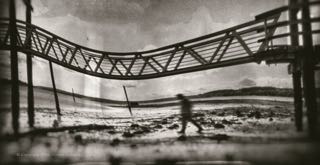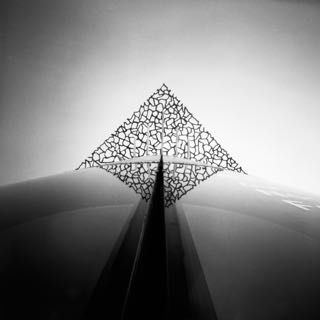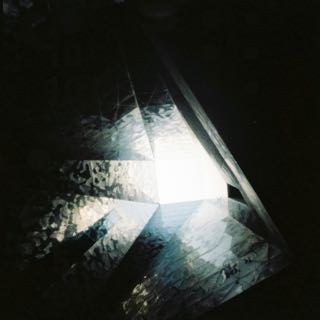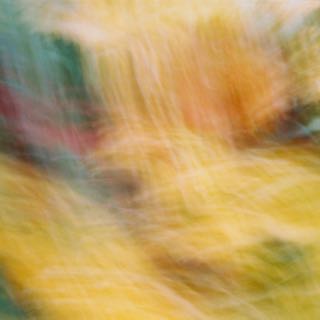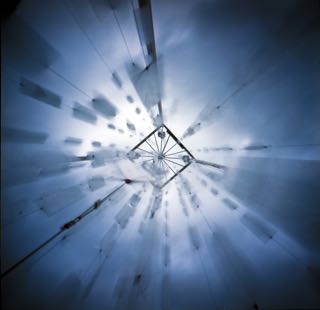Steven Dempsey is a storyteller. After years as a musician, he started a filmmaking company where he produced documentaries and music videos. Nearly a decade of producing films has ingrained in him the motion photographer’s sense of progress in a scene. He’s certainly not the first motion photographer turned still photographer I’ve seen, but you can always feel the transitional moment of a story when the work is done by a motion photographer.
Steven, who shoots his pinholes digitally with a body cap, has found that the unique properties of pinhole gives him a powerful tool to realize his storytelling vision. As you’ll soon see below, his photos are more like short, single frame vignettes. One can see the transition from scene to scene – a kinetic energy that is off camera, in the viewers’ mind.
I hope you enjoy this short conversation with Steven. Afterwards, we invite you to check out his website, his blog, and especially his Slate pieces on pinhole – Through a Pinhole and Pictures in Motion.
You and your wife are traveling the country in an RV – this is a dream for any photographer to have access to so much location. How do you make sure, in these new locations, that you find shooting locations that hold meaning for you?
I have always had a childlike wonder for the world around me. So many things inspire me no matter where I am. I crossed a threshold a few years ago where the camera became a part of me, like an extra limb or a new set of eyes. When I look around me, I see photographs in my mind before I even look through the viewfinder. The physical location is only part of the equation for me. The circumstances have to be right, whether it’s the light or the time of day, or if tourists are around making it difficult to capture the scene, etc.
When I saw the Grand Canyon for the first time a couple of years ago, it was more spectacular than I could have possibly imagined. There were thousands of people there for the sunset. I’ve never seen so many selfie sticks and iPads! I shot a handful of meaningless photographs and decided to spend more time just experiencing the place. The next morning I was there for the sunrise at 5:30 and I shared that spectacle with only four other people. This was my Grand Canyon! I wanted to capture how I felt right there and my response to the sun rising. I shot those photographs in black and white because it more closely approximated the wonderful simplicity of the canyon in silhouette.
These are the experiences I seek out when I arrive at a new location. I spend a little time snapping the usual iconic shots and then, when I relieve myself of that pressure, I begin to look around the area for more interesting details. I’m particularly drawn to compositions that are devoid of any modern elements. If I can help it, I won’t include people dressed in modern day clothing and I’ll also avoid cars or anything that can date the photo. Timelessness is a big part of my imagery.
Having said all that, I am sometimes more drawn to an abandoned town next to the big postcard view. Even an old chair can have the same impact as the grandest mountain, it just depends on the photographer’s perspective. It all boils down to authenticity, finding the truth in something…that’s what I’m after at the end of the day.
[singlepic id=310 w=600]Forgotten Abode, ©Steven Dempsey 2016[/singlepic]
You have a number of stories that you’ve put together on Adobe Slate, which seems to be a great storytelling platform. For other photographers considering it, what are the pros and cons that you’ve found so far?
The pros are easy to talk about. It’s portable because I have my iPad with me most of the time and I can write a story just about anywhere. I’m more inclined to actually write blog posts because of this convenience. Slate is also now available on the web so it can be accessed by anyone with a computer. Because Adobe includes templates, the look of all my stories is similar which almost feels like a kind of branding for me. The finished product is always elegant and I don’t have to worry about having to design and maintain my own blog, etc.
The big downside is that it is in a proprietary format and if, at some point, Adobe either goes out of business or chooses to stop supporting the app, what happens to all of my work?
The most important piece of advice I would give anyone considering using Slate or anything else like it is to make sure you have strong content. Story is king and it doesn’t matter how fancy a wrapper you put around bad writing, it’s still bad writing and will not engage an audience.
[singlepic id=316 w=600]Silhouette at the Water’s Edge, ©Steven Dempsey 2016[/singlepic]
You mention to me that you feel that in your prior venture, Americonic Films, you “said all [you] had to say with video and found a new passion in photography.” How did you know that it was time to find something new? What new things have you discovered in your creative expression since making the switch?
I had been working as a filmmaker for about eight years, concentrating on documentaries and music videos. Additionally, I was creating nature vignettes for myself. I noticed a trend in my shooting style where my personal videos were beginning to look more like photographs. I quit moving the camera around and found that I really liked the sense of calm it created. Meanwhile, in the real world, things were taking a nose dive. When the recession hit in 2007, people didn’t have the money to pay for videos. Project opportunities eventually dried up.
A friend of mine had just gotten the newly-released Canon 5D Mark II and wanted me to review it. I was only thinking of its video capabilities at the time but I began shooting photographs too. I kept the setting on black and white and soon became addicted to capturing stills. I barely used the video setting at all. As soon as I had to give the camera back, I ordered my own.
I remember one particular photograph that changed my life. There was an old broken paddle in my backyard (we lived by a lake at the time). It didn’t look like anything special but I shot it anyway. Later, when I looked at the image on my computer screen I was actually shocked. It had a magical quality to it, like the camera had transported it to another world. I stared at the black and white photograph on my screen for days. After that experience, I began “seeing” things on a more profound level and I knew photography was the next important chapter in my life.
I believe that, in order to make good pictures, It takes patience and skill. I think an artistic sensibility is also an important element. I watched an Ansel Adams documentary once and a commentator, talking about Adams, said, “A poet has access to the same words as everyone else. He (or she) just knows how to put them in the right order.” Similarly, a photographer extracts all the important elements from a scene and makes a unique photograph.
[singlepic id=314 w=600]Still From a Dream, ©Steven Dempsey 2016[/singlepic]
In Pictures in Motion, you talk about your transition from video to photography and the mental shift that that entailed. Specifically, you mention that the long exposure photograph “frees you from the shackles of split-second shutter speeds”. Do you find that, in pinhole, the challenge becomes finding subject matter that is made more meaningful by the passage of time?
I absolutely approach pinhole photography with a different mindset. I want to exploit what it has to offer. I don’t necessarily see the point in shooting a landscape that has no movement with a pinhole because it will just look like an out-of-focus photograph. This is more of an issue in the digital pinhole world. I have seen almost tack sharp images from photographers using large format film. So, with the limitations of my medium, I will include water or a person or clouds or something that is showing the passing of time. The blurring that occurs from long exposure motion also becomes the subject itself and is the focal point of my composition on many occasions.
[singlepic id=313 w=600]Self Portrait, Field, ©Steven Dempsey 2016[/singlepic]
You often take pinhole photos that include a self-portrait element. What was the creative impetus for this approach? What is your process in creating these photos?
I’m the best model I know! I show up on time and I do everything that’s asked of me 🙂 Actually, because of my lifestyle on the road and my preference for getting up at the crack of dawn, I don’t have access to other people so including myself is the most efficient way to do it. I feel like including a human element in my images elevates them and helps with their ethereal quality. I’ve always been interested in ghosts and distorted reality. Sometimes I want to give the impression that my camera has serendipitously captured something otherworldly, unseen by the naked eye. That kind of thing just gets my adrenaline going.
My approach is usually spontaneous. I’m not the kind of person who will go scouting out a location in advance, look at all the data on sun positions and the like. I’ll have some vague idea of where I want to go based on a cursory search on Google. I have an app on my iPad called “Stuck on Earth” and it’s basically a mapping software that includes geo-tagged photos from Flickr. You pull up your location and can see photos people have taken all around the area. If I see something of interest, I’ll make a plan to go there.
The first thing I do is determine the light level and what shutter speed I have to work with. I’ve determined that my current pinhole is about f/114 and I keep my ISO at the camera’s native 200 as much as possible. If it’s a sunny day, I’ll only have a second or two of exposure time, if it’s dull, I’ll have about five or six seconds. If I include myself in the shot, I’ll sometimes have to move slower or faster than is natural when I trip the shutter based on the motion effect I want. It’s a pretty free-flowing process so one idea begets another and sometimes I’ll yield three or four good ideas during a single shoot. Of course, having instant access to a digital photo gives me a great advantage. If something doesn’t look right, I’ll simply do it again. I wouldn’t have that luxury shooting film.
[singlepic id=312 w=600]Self Portrait, Dock, ©Steven Dempsey 2016[/singlepic]
In Pictures in Motion, you mention that you’ve “never been completely satisfied shooting images of beautiful scenery”. You expound on the point, mentioning that you don’t feel like they “belong to [you]”. That’s a very interesting thought and I almost sense some of what is described as “imposter syndrome” – where the individual senses a lack of legitimacy. Is that the root of your dissatisfaction? Or is it something else?
What an interesting question! I used to feel that way when I was a performing musician way back in the day. I would experience terrible stage fright and a feeling that I might be called out as a fraud because of my lack of confidence but I don’t feel that way about my photography.
What I was referring to in my blog post is a need I have to express my own individuality in my work…my own voice, if you like. I have the technical chops to produce a good conventional photograph but it doesn’t look much different to me than a hundred more like it on the web. Capturing a likeness of a place does not satisfy my inner creative appetite because when I look at one of these kinds of photographs a second time, it still looks the same as the first. There is not a need to use my imagination.
Shooting pinhole photographs is an entirely different experience. For me it’s all about using my imagination, from the moment I see a scene through capturing it through post production and finally to viewing the finished picture. It continually morphs with each step. My most favorite pinhole images keep telling new stories when I revisit them. It’s like layers of an onion being slowly peeled away. I find that this kind of abstract photography can mirror my state of mind. If I come to it with a particular emotion or feeling, it will influence how I see the image so it’s ever-changing. That doesn’t happen with a “regular” photograph. Like I said, a tree is just a tree. Sure there is some individuality in how I capture it but pinholing is in a different league. It is intensely satisfying down to the inner workings of my soul. Yes, seriously.
[singlepic id=311 w=600]Ferry House Ghost, ©Steven Dempsey 2016[/singlepic]
That’s interesting that you mention your pinhole photos changing to “mirror [your] state of mind.” It reminds me of the Ansel Adams line, “There are always two people in every picture: the photographer and the viewer.” Do you find yourself looking to say something specific to your viewers with your images? Or do you perhaps prefer to stir yourself, and therefore, also stir your viewer?
I never consider an audience when I’m shooting. I’m only interested in stiring something inside myself.i don’t think this is selfish behavior, rather, it is pure expression. If I feel distracted by second-guessing what a viewer will think, the idea is already diluted.
[singlepic id=315 h=600]Pinhole Trail, ©Steven Dempsey 2016[/singlepic]
We applaud Steven in his willingness to share some insight into his ongoing pinhole work and I hope you’ve gained some insight into your own creative strides. Again, we encourage you to take a look at his website, his blog, and pay particular attention to his Slate pieces on pinhole – Through a Pinhole and Pictures in Motion.
